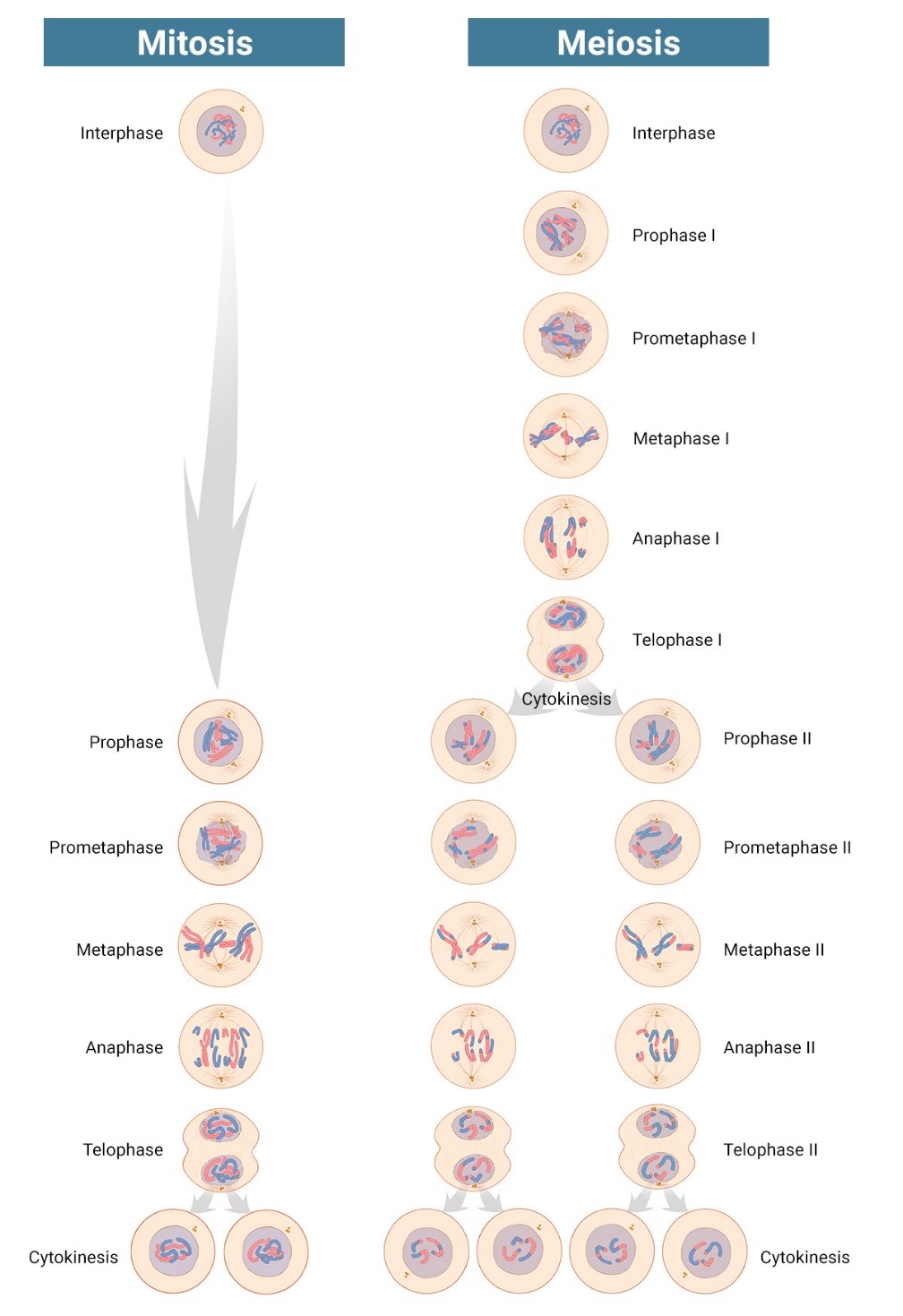Your body is made up of trillions of cells that all originate from just one—a fertilized egg. The massive multiplication of cells after conception is possible thanks to cell division, which occurs when one cell splits into two. Cell division not only enables growth but also replaces damaged or dead cells and makes reproduction possible. There are two kinds of cell division: mitosis and meiosis.
 Mitosis is shown on the left, and meiosis is shown on the right. Credit: Judith Stoffer. Click to enlarge
Mitosis is shown on the left, and meiosis is shown on the right. Credit: Judith Stoffer. Click to enlarge
What’s the Difference?
Mitosis produces two genetically identical “daughter” cells from a single “parent” cell, whereas meiosis produces cells that are genetically unique from the parent and contain only half as much DNA. Many cells in the body go through mitosis, but some do so more often than others. For instance, those that line the stomach replace themselves after just a few days because they’re subjected to strong digestive acids. In contrast, liver cells may wait up to a year to replace themselves. There are also a few types that last a lifetime without dividing, such as some nerve cells and cells that make up the lens of the eye. Meiosis occurs only in the production of sperm and egg cells for sexual reproduction.
The Phases of Cell Division
Before either mitosis or meiosis occurs, cells go through a preparatory process called interphase, where they grow and make a copy of their genetic information.
Mitosis has six phases apart from interphase. The first five phases divide the nucleus and its genetic information in half, while the final step splits the entire parent cell into two identical daughter cells. The phases of mitosis are:
- Prophase: Chromosomes, which contain genetic information, condense and prepare to attach to the spindle—a cellular machine that moves chromosomes during cell division.
- Prometaphase: The nuclear membrane—a structure that typically contains the chromosomes—breaks apart, the spindle forms, and chromosomes attach to its strong, hollow fibers.
- Metaphase: Chromosomes align along the spindle’s center.
- Anaphase: Chromosomes pull apart and move toward the spindle’s poles, which also move apart.
- Telophase: New nuclear envelopes form around the two separated sets of chromosomes.
- Cytokinesis: Cells divide.
Meiosis has similar steps to mitosis but with two sets of divisions. The first division results in two cells that each have two sets of chromosomes, like in mitosis. The second division creates four cells that each contain one set of chromosomes, because the genetic information isn’t copied a second time. One unique feature of meiosis, which takes place during the first round of prophase (prophase I), is a process called crossing over. DNA is mixed between matching chromosomes from the different parents, increasing the genetic diversity.
NIGMS-Funded Cell Division Research
Many scientists who are supported by NIGMS study cell division. Some of these researchers are investigating how cells:
- Maintain normal cell division through aligning and separating chromosomes via the spindle during mitosis and meiosis
- Prevent genetic errors from being introduced during crossing over in meiosis
- Decide to either grow and divide or enter a resting phase, which is important in understanding diseases caused by excessive or insufficient cell division


Well done
hi can you help to differentiate meiosis stage with mitosis stage
Thanks for your question, Robert. If you’re asking about the different steps of each process, we’ve described the phases (some call them stages) of mitosis and meiosis in the post. If you’d like to see visuals of the process of mitosis, check out our Slideshow: Mitosis Masterpieces post!
Thanks a lot it helped
wow. I love mitoesieis,
are not the cells that start both mitosis and eoisis the same, asexual cells? I don’i understand “matching chromosomes from the different parents” during crososover. Where did the parents come from? Also the article talks about chromosomes like they are separate, individual entities. (I’ve seen this else where). Aren’t they sections of DNA? What happens to DNA during meiosis? I am not a microbiologist, just an engineer trying to understand evolution.
Hi Bill, thanks for your questions. Yes, cells that divide via mitosis or meiosis both begin as somatic cells, or cells that are not reproductive cells. You are correct that chromosomes contain DNA, but the structuring of the DNA into chromosomes is important. A chromosome packages a single molecule of DNA around proteins in a tight, spool-like fashion. If all of the DNA molecules in a single human cell were unwound from those proteins and placed end-to-end, they would stretch 6 feet. Do this for all your DNA, and the resulting strand would be 67 billion miles long—the same as about 150,000 round trips to the Moon! So chromosomes play an important role in storing DNA molecules so that they fit in cells. During meiosis, the DNA is replicated and divided similarly to the process that occurs during mitosis, but a second division creates four cells that each contain one set of chromosomes because the DNA isn’t copied a second time. Crossing over is also a process unique to meiosis, in which chromosome partners, one inherited from each parent, physically swap sections with one another. The final chromosomes are hybrids of the originals, so you couldn’t point to one complete chromosome as being from one parent and the second from the other parent.
Thank you so much… this article really helped a lot
Has eased studies n research.share more